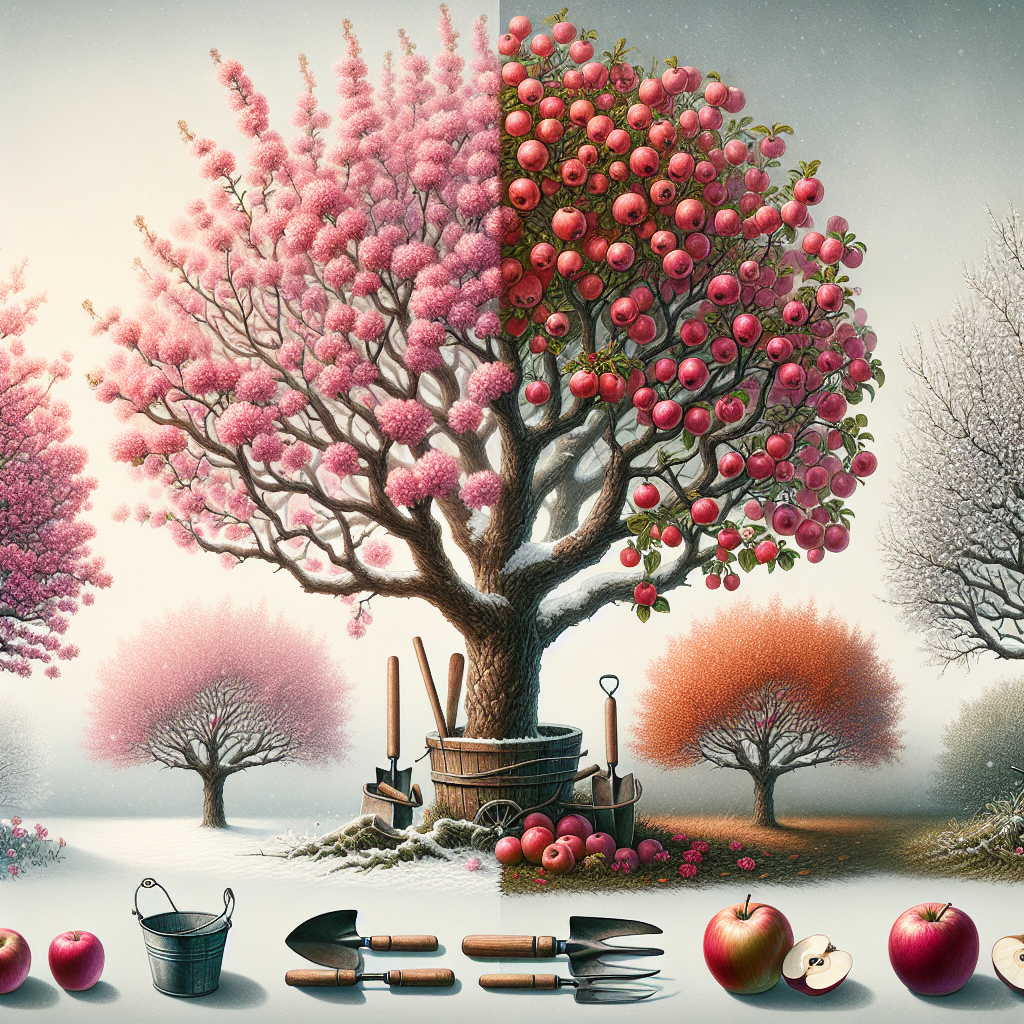Mastering the Art of Growing Crabapples
Updated July 11, 2024 at 10:17 am

“`html
- Pet Friendly: Generally safe, but the fruit can be a choking hazard or cause digestive upset if consumed in large amounts.
- Light Requirements: Full sun is ideal for flowering and fruit production.
- Watering: Regular watering until established; then drought-tolerant.
- Humidity: Tolerates a wide range of humidity levels.
- Temperature: Hardy in USDA zones 4 through 8.
- Difficulty: Moderate; requires some maintenance such as pruning and disease management.
Choosing the Right Crabapple Tree for Your Garden
When diving into crabapple cultivation, the variety of choices can seem overwhelming. With the correct selection, though, you’ll be set up for growing success. Different varieties offer distinct features, from stunning fall colors to persistent fruits that add winter interest.
One particular favorite among gardeners is the Malus ‘Prairifire’, known for its vibrant pink flowers and disease resistance. It’s a beautiful choice that offers your garden a splash of color along with minimal maintenance frustration.
Find This and More on Amazon
Site Selection and Soil Preparation
Finding the perfect spot to plant your crabapple tree is pivotal. Aim for a location with well-draining soil and full sun exposure to encourage the best floral display possible and to help avoid diseases. Avoid planting in low areas where cold air or frost can settle.
Soil conditions also play a critical role. When preparing the planting site, mix in organic compost to enrich the soil with nutrients. Conducting a soil test beforehand to determine pH and additional nutrient needs is always a good idea. Slightly acidic to neutral soil pH is ideal for crabapples.
Planting and Initial Care
When planting your crabapple, ensure the trunk’s flare, where it expands at the base, is above ground level. Deep planting can lead to root rot and lower trunk issues. After planting, thorough watering helps settle the soil. Mulch can help retain moisture and regulate soil temperature.
During the first growing season, your crabapple will rely on you for consistent moisture. Be attentive but not excessive; overwatering can harm your tree. It’s a delicate balance but key to establishing a strong, resilient specimen.
Pruning and Maintenance
Pruning your crabapple tree is essential for its health and aesthetic. Remove any dead or diseased branches, and thin out the canopy to allow light and air to penetrate. Good practices like these can drastically decrease disease pressure.
The best time to prune is late winter or early spring before the new growth starts. For varieties prone to suckering, such as Malus ‘Sargentii’, regular removal of these vigorous shoots will keep your tree in check and looking tidy.
Fertilizing and Growth Management
Young crabapple trees benefit from an annual dose of balanced, slow-release fertilizer applied in early spring. Established trees are less demanding. If growth seems excessive or your tree is pushing out lush, soft wood prone to pests and diseases, it may be wise to skip fertilization for a season and assess the tree’s condition.
Crabapple trees typically experience a moderate growth rate, so be patient, and you’ll see your efforts rewarded. If you feel uncertain about what fertilizer to use, a brand like Osmocote’s Smart-Release Plant Food, with an N-P-K ratio perfect for trees, is an excellent start.
Find This and More on Amazon
Disease and Pest Management
Common foes of crabapple include fungal diseases like apple scab and cedar-apple rust. These can be managed with proper sanitation, such as removing fallen leaves, and fungicides if necessary. Always opt for disease-resistant varieties if you’re in a region prone to these issues.
As for pests, aphids and Japanese beetles might visit your trees. You can handle aphids with a strong burst of water from a hose or use insecticidal soap. For Japanese beetles, products containing neem oil, like Safer Brand Neem Oil Concentrate, can be effective when applied per the instructions.
Find This and More on Amazon
“`
Watering Techniques and Mulching Tips
Understanding the watering needs of your crabapple tree is key to its survival and flourishing. During the first year after planting, it’s crucial to water deeply once a week, allowing the soil to dry out somewhat between watering sessions. This encourages deep root growth.
Mulching is equally important for moisture retention and root protection. Apply a 2-3 inch layer of organic mulch, keeping it a few inches away from the trunk to prevent rot and rodent damage. Mulching also helps control weeds, which compete with your tree for water and nutrients.
Recognizing and Responding to Stress Signs
Crabapples are hardy, but they’re not immune to stress, which can manifest in several ways, including leaf yellowing or premature fruit drop. Stressed trees are more susceptible to disease, so it’s important to identify signs early and address any issues.
Overwatering, for example, can lead to oxygen-deprived roots, which can cause leaves to turn yellow and wilt. Adjust your watering schedule as necessary, and ensure your tree’s site has adequate drainage. If you suspect disease, remove any affected areas and consider consulting with a local arborist or cooperative extension service for advice.
Flowering, Pollination, and Fruit Development
Flowering is one of the crabapple’s most anticipated events, signaling the start of pollination and fruit development. Certain varieties, such as ‘Robinson’ or ‘Red Jewel’, are renowned for their blossoms and can become local showpieces.
For abundant fruiting, prominent pollinators like bees must have access to the flowers. Some crabapple varieties are self-fertile, while others may benefit from cross-pollination. If you aim for a bountiful harvest, consider planting more than one variety to ensure good cross-pollination.
Landscape Design and Companion Planting
Incorporating crabapples into your landscape design offers a variety of stunning visual effects throughout the seasons. These trees can be used as focal points, in a hedgerow, or even espaliered against a wall for a more formal look.
When choosing companion plants, consider those that complement the crabapple’s growth habit and seasonal colors. Spring-flowering bulbs, like daffodils, can mirror the bloom time of your tree, while groundcovers such as Vinca minor provide contrasting foliage and blooms beneath its canopy.
Creating Wildlife Habitat with Crabapples
Crabapple trees not only beautify your garden but also serve as important sources of food and shelter for wildlife. Birds, in particular, are drawn to the fruits, and the dense foliage provides excellent nesting sites.
Planting a crabapple tree like the ‘Donald Wyman,’ with small fruits that remain on the tree through winter, gives birds a reliable food source during the lean months. Plus, watching birds and other wildlife visit your garden adds an extra layer of enjoyment to your crabapple experience.
Winter Care and Protection
Despite being cold-hardy, young or newly planted crabapple trees may need some winter protection. Mulch applied in the fall insulates the root zone. For additional protection, a tree wrap can prevent sunscald and damage from animals.
Also, it’s important to ensure your crabapple receives adequate water in the fall before the ground freezes. This helps prevent drought stress, which can be detrimental, especially during a dry winter. Remember to remove any protective wraps in the spring to avoid moisture buildup and pests.
Harvesting and Using Crabapples
Crabapples are not just ornamental but can be harvested and used in a variety of culinary creations. The fruits typically mature in late summer to fall and can be picked once they have fully colored and taste slightly sweet yet tart.
You can use crabapples to make delectable jellies, pies, and sauces. The Malus ‘Dolgo’ is particularly known for its excellent fruit flavor and is a great option if you’re interested in cooking with crabapples. Just make sure to remove the seeds, as they contain compounds that can be toxic in large quantities.
Encouraging Eco-Friendly Gardening Practices
As a crabapple enthusiast, adopting eco-friendly gardening practices not only benefits your tree but also the environment. Opting for organic mulch, natural pest control methods, and reducing chemical use are steps in the right direction.
Encouraging beneficial insects by planting a variety of flowering plants and providing nesting habitats can help manage pest populations naturally. Additionally, collecting rainwater for irrigation is an excellent way to conserve water and support a healthy, sustainable ecosystem around your crabapple tree.
Practical Tips for Repotting Crabapple Trees
If you’re growing a crabapple tree in a pot, repotting every few years is crucial for maintaining its health. As a rule of thumb, upgrade to a pot that’s a couple of inches larger in diameter than the current one to give the roots room to spread.
When repotting, gently remove the tree from its old container, prune any damaged or circling roots, and place it in the new pot with fresh potting soil. This will reinvigorate your tree and encourage a new flush of growth.
Consistent Monitoring for a Healthy Crabapple Tree
Maintenance of a crabapple tree requires vigilance. Regularly check for signs of ill-health like canker, rust, or mildew, especially during warm, moist conditions when such issues thrive.
Keep an eye on the trunk, branches, leaves, and especially the fruit. If you notice anything out of the ordinary, handle it promptly. Simple steps like these can prevent minor problems from becoming major setbacks in your crabapple tree’s life.
Inspiring Community Engagement through Crabapple Cultivation
Crabapples aren’t just a personal joy; they can also be a way to engage your community. Consider starting a crabapple enthusiasts group or participating in local tree-planting initiatives. Sharing experiences and wisdom can be incredibly rewarding.
Organizing local workshops or tree walks during flowering time can also spark interest in crabapple cultivation. By fostering a community around these trees, you contribute to a wider appreciation and understanding of their value.
The Joy of Growing Crabapples: A Summary
Growing crabapples can be an incredibly enriching endeavor, bringing beauty, wildlife, and delicious fruits into your life. By choosing the right variety, understanding the tree’s needs, and providing the appropriate care, you can nurture a tree that thrives and contributes to the environment.
Whether you’re an experienced gardener or a beginner, the art of growing crabapples offers endless learning and enjoyment. The resilience and charm of these trees make them an excellent addition to any garden, and the sense of accomplishment you’ll feel as they flourish is unmatched.
Shop more on Amazon

